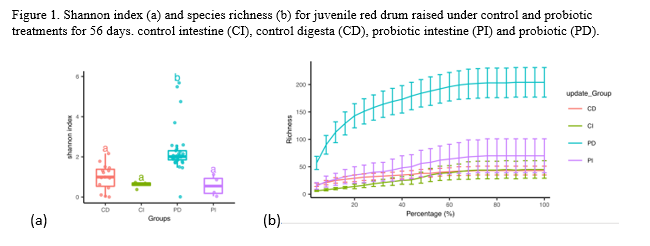EFFECTS OF A MULTI-STRAIN PROBIOTIC (PRIMALAC®) ON THE GUT MICROBIOME OF THE MARINE FISH RED DRUM Sciaenops ocellatus
The gut microbiome of the commercially important marine fish, red drum (Sciaenops ocellatus ), has important implications for commercial and recreational fishing, as well as aquaculture, because of the importance of the microbiome on host health and disease susceptibility. In aquaculture, while the aquatic environment provides a continuous source of microbes to the host along with the feed, supplementation in the form of prebiotics and/or probiotics, is becoming more popular. Yet little is known about the effects of probiotic supplementation on the native species richness and/or diversity of the gut microbial communities, and their importance to fish health. To begin to fill this gap in knowledge, we raised juvenile red drum for 56 days in three treatments:1) control (no probiotics), 2) a water-soluble multi-strain probiotic (PrimaLac ®, ( Lactobacillus acidophilus, Lactobacillus casei , Bifidobacterium bifidium, and Enterococcus faecium) was added to tank water and, 3) PrimaLac ® was commercially added to the feed in an enhanced starter feed (PESF). Following harvesting the intestine for histology and weighing the digesta, the intestine (autochthonous bacteria) and digesta (allochthonous bacteria) were profiled for microbial composition using 16S rRNA sequencing. Bioinformatic analysis included calculation of alpha diversity using the Shannon index, which measures the number of species and relative species abundances, and beta diversity using the Jaccard distance, which accounts of presence and absence of species. Preliminary results revealed robust taxonomic shifts in the Shannon index and richness of the gut microbiome in the probiotic treatments compared to controls (Fig. 1a, b). Interestingly, in the probiotic treatments, microbial species diversity and richness was significantly higher in the digesta than in the intestine. For controls, no differences existed between digesta and intestine. In addition, species diversity and richness of the intestinal samples from the probiotic treatment did not differ from those of either the control digesta, or the intestine (Fig. 1a, b). Further analysis will determine the relative taxonomic identity, as well as the presence or absence of pathogenic bacteria, among treatments and microbial sources (digesta vs intestine) and will provide valuable data of the value of probiotic supplementation for improving the quality of health for this fish species in aquaculture settings.
